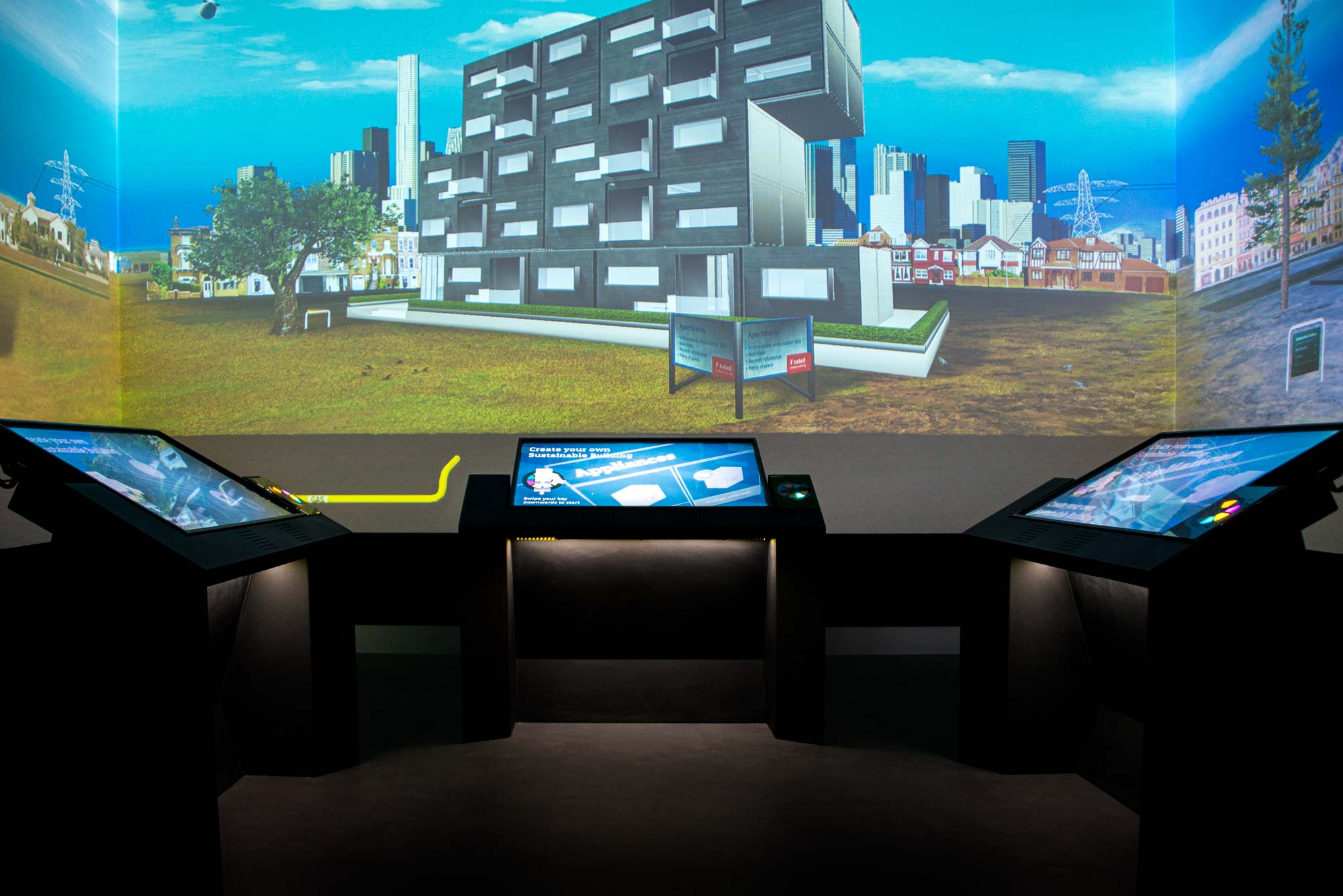The Crystal
September 2012
The Crystal is a sustainable cities initiative by Siemens exploring how we can create a better future for our cities. Home to the world's largest permanent exhibition focused on urban sustainability, it reveals the challenges that cities face, and the ways we can reduce their environmental impact using sustainable technology.
Create Your Own Sustainable BuildingDesigning a modern building involves making a myriad of decisions, all of which have an impact on its sustainability rating. Create Your Own Sustainable Building is a large-scale, immersive environment where visitors undertake this challenge, and are rewarded by seeing their designs for an office, block of flats, or a house build instantly in front of them.
By interacting with a digital blueprint on large format touchscreens, visitors can discover and see for themselves the impact their choices are having. From selecting the type of light switch to install, right up to installing the most advanced type of thermal recovery heating, every decision influences the appearance and energy rating of the building.
Up to three players can use the exhibit at the same time, and bystanders in the space can influence the responsive environment by moving around the space. The realtime 3D graphics includes trees swaying, birds flying and a zeppelin that tracks visitors' motion around the space.
This large-scale immersive environment consists of three large format touchscreens, three HD projectors, and seven separate systems, synchronizing with each other using realtime network messaging. Realtime computer vision is used to detect motion in the space. Each of the touchscreen consoles is launched by the user swiping their RFID based smart-ticket, and the seamless design of the projections creates a single vista that fills 3 sides of the room.
Understanding CitiesA sustainable city is a complex system of interrelated parts; planning and managing a city requires making a significant number of critical decisions. Understanding cities lets the visitor explore these interdependences using real data from New York City in a simple and intuitive way.
Understanding Cities allows up to ten different layers to be overlaid onto an interactive map of New York City. Visitors can zoom into the map to look at details, discovering more about the zoning, infrastructure and layout of a modern city.
The exhibit is launched by the user swiping their RFID based smart ticket, and relies on intuitive touch gestures that are familiar, making it easy to use.
Rapid ResponseUnexpected incidents and emergencies are commonplace in all urban environments. How can smart systems be used to improve the emergency responses that are despatched on a daily basis? Rapid Response is a one or two player game where the main player tries to respond to incidents as quickly as they can.
A second player can join in the fun, creating incidents in the fictional city by dragging icons onto a map. As their opponent responds to the incidents, the emergency services are seen traveling between locations.
After the player has discovered how challenging it can be keeping tabs on all the incidents, they switch to using an intelligent response system, which collects relevant information and makes smart suggestions as to which services are required and where. Using this advanced system, incidents can be responded to quicker, saving lives and reducing the impact on the city.
This multi-screen, two player exhibit is launched by the user swiping their RFID based smart-ticket, integrates into a CMS-driven presentation framework provided by ISO Design, and synchronizes content across screens by sending realtime data over a network.
Crowd ControlWith growing number of people using public spaces, it is increasingly important to keep large groups of people safe. Monitoring crowds enables us to understand where problems can occur and how to prevent them. The Crowd Control exhibit simulates a couple of scenarios where overcrowding can be dangerous, and challenges the visitor to make changes to the environments to prevent crowd congestion before it happens.
Presenting a profile view of an underground station and a football stadium, the player can see crowds of people as they move through the space. By tapping on ticket gates, barriers and objects within the environment, the game shows how a small change can have a big impact on a crowd.
This touchscreen exhibit is launched by the user swiping their RFID based smart-ticket, and integrates into a CMS-driven presentation framework provided by ISO Design.
Protecting the CityMonitoring technology enables us to spot crimes before they take place, detect them quickly and capture criminals. Protecting the City challenges the visitor to set up a smart surveillance system, and then use it to find a suspect package in a busy airport.
Posed as a multi-stage challenge, the visitor is introduced to the concept of a virtual barrier, whereby automated systems detect unusual activity within a defined zone of an airport. Intelligent computer vision systems scans live imagery from surveillance cameras, detecting known faces of criminals, tracking number plates of vehicles, and locating suspect packages.
The player finishes the game by discovering that surveillance systems play an important part of an investigation after an incident occurs. They are asked to look through recorded footage from cameras to pick out key pieces of evidence that secures the conviction of a potential terrorist plot.
This touchscreen exhibit is launched by the user swiping their RFID based smart-ticket, and integrates into a CMS-driven presentation framework provided by ISO Design.

A Sustainable Cities Initiative by Siemens